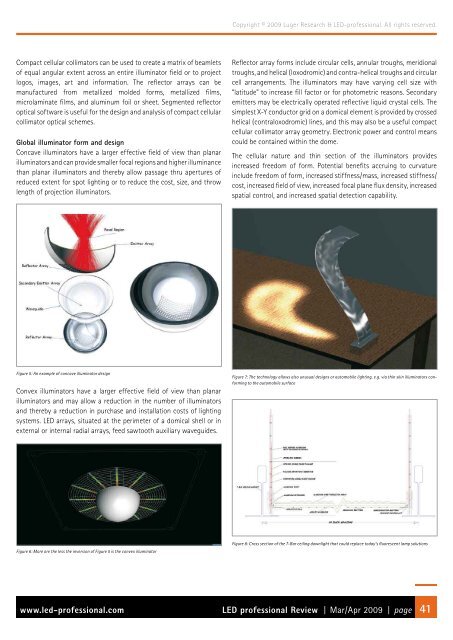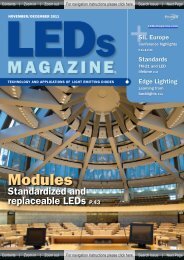LED Applications & Lighting Systems - fonarevka
LED Applications & Lighting Systems - fonarevka
LED Applications & Lighting Systems - fonarevka
Create successful ePaper yourself
Turn your PDF publications into a flip-book with our unique Google optimized e-Paper software.
Copyright © 2009 Luger Research & <strong>LED</strong>-professional. All rights reserved.<br />
Compact cellular collimators can be used to create a matrix of beamlets<br />
of equal angular extent across an entire illuminator field or to project<br />
logos, images, art and information. The reflector arrays can be<br />
manufactured from metallized molded forms, metallized films,<br />
microlaminate films, and aluminum foil or sheet. Segmented reflector<br />
optical software is useful for the design and analysis of compact cellular<br />
collimator optical schemes.<br />
Global illuminator form and design<br />
Concave illuminators have a larger effective field of view than planar<br />
illuminators and can provide smaller focal regions and higher illuminance<br />
than planar illuminators and thereby allow passage thru apertures of<br />
reduced extent for spot lighting or to reduce the cost, size, and throw<br />
length of projection illuminators.<br />
Reflector array forms include circular cells, annular troughs, meridional<br />
troughs, and helical (loxodromic) and contra-helical troughs and circular<br />
cell arrangements. The illuminators may have varying cell size with<br />
“latitude” to increase fill factor or for photometric reasons. Secondary<br />
emitters may be electrically operated reflective liquid crystal cells. The<br />
simplest X-Y conductor grid on a domical element is provided by crossed<br />
helical (contraloxodromic) lines, and this may also be a useful compact<br />
cellular collimator array geometry. Electronic power and control means<br />
could be contained within the dome.<br />
The cellular nature and thin section of the illuminators provides<br />
increased freedom of form. Potential benefits accruing to curvature<br />
include freedom of form, increased stiffness/mass, increased stiffness/<br />
cost, increased field of view, increased focal plane flux density, increased<br />
spatial control, and increased spatial detection capability.<br />
Figure 5: An example of concave illuminator design<br />
Convex illuminators have a larger effective field of view than planar<br />
illuminators and may allow a reduction in the number of illuminators<br />
and thereby a reduction in purchase and installation costs of lighting<br />
systems. <strong>LED</strong> arrays, situated at the perimeter of a domical shell or in<br />
external or internal radial arrays, feed sawtooth auxiliary waveguides.<br />
Figure 7: The technology allows also unusual designs or automobile lighting, e.g. via thin skin illuminators conforming<br />
to the automobile surface<br />
Figure 6: More ore the less the inversion of Figure 5 is the convex illuminator<br />
Figure 8: Cross section of the T-Bar ceiling downlight that could replace today’s fluorescent lamp solutions<br />
www.led-professional.com <strong>LED</strong> professional Review | Mar/Apr 2009 | page 41

















